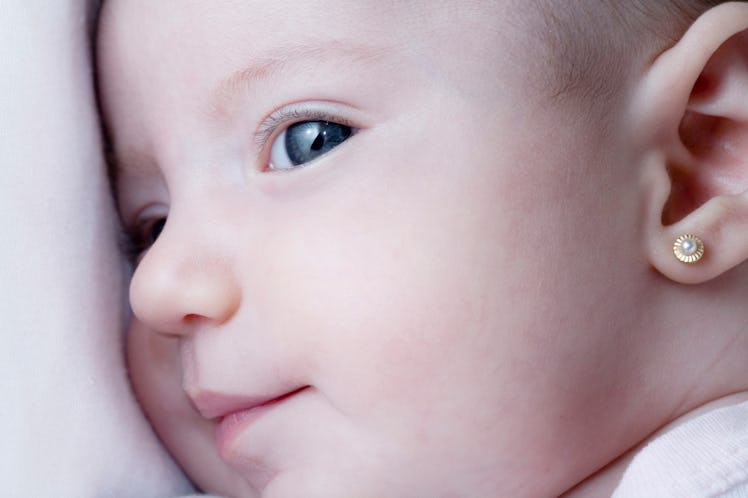When Can You Pierce A Baby's Ears? A Pediatrician Explains
There are some ground rules to baby ear piercing, but for the most part it’s totally safe.

Baby ear piercing is a common practice across many cultures. However, medical organizations such as the American Academy of Pediatrics (AAP) recommend that parents wait until children are old enough to make the decision for themselves before piercing their baby’s ears. When cultural values come into conflict with professional consensus, it can be hard to navigate. So when can you pierce a baby’s ears safely? There are a few key factors to consider.
First, parents should understand that the AAP’s recommendation is less an indicator that infant ear piercing puts children in immediate danger and more an effort to let children make decisions about their own bodies. Another benefit of waiting until babies are older before piercing their ears is that they can, at that age, care for their piercings themselves, reducing the possibility of an infection. But as long as parents take on that responsibility for their infants, piercing a baby’s ears is generally safe.
When Can Babies Get Their Ears Pierced?
The age when you can safely pierce a baby’s ears is around 2 months, as long as parents follow a few rules. Infant ear piercing at 2 months is arguably an ideal time because it coincides with the first round of vaccinations, including the tetanus vaccine. Although that’s a comforting precautionary measure, there is very little risk a baby would get tetanus from an ear piercing even without the vaccine.
Getting ears pierced early is also better for pain. “Babies can’t localize pain, so even though it might be a little bit painful, they can’t reach up and touch their ears and pull the earring out,” says Norina Ocampo, M.D., a pediatrician at West Boca Medical Center in Florida. “The pain usually goes away within a couple of days.”
Older babies, around 5- or 6-months-old, however, can localize pain. They may be more apt to tug and pull at the earrings. That’s even more problematic if their fingers and hands are dirty.
And the older a child is, the more likely they will be stressed or frightened when it comes to ear piercing, even if they have made their own decision to have the procedure done. “These 4- and 5-year-olds want their ears pierced, but then they’re crying because they’re afraid of the pain,” Ocampo says. “I think it’s better to do it as a baby when they don’t know, and then it’s done.”
Ocampo notes that some pediatricians are willing to pierce a baby’s ears in the safety of their office. But if parents can’t find a doctor to do it, they should insist on several guidelines wherever the piercing occurs. Not only should they look to get their baby’s ears pierced in a clean environment, but 24-karat medical-grade gold-plated studs are the only appropriate baby earrings. Sticking to these standard will help prevent infection and allergic reactions.
“You will never have a reaction to pure gold,” Ocampo says. “People who are allergic are not allergic to the gold; 14-karat and 18-karat are not 100% pure, so they add other alloys like nickel. It’s usually the nickel they have an allergic reaction to. Twenty-four-karat gold is pure gold.” Who knew babies had such expensive taste?
Concerns of Piercing a Baby’s Ears
Once a child’s ears are pierced, they will remain so permanently if the earrings are kept in for at least a week after piercing. During that time, parents can prevent rare cases of infection by cleaning around the baby earrings with alcohol and rotating the studs in their holes twice daily.
Signs of infection include redness and tenderness, and possibly a pus-filled discharge. But Ocampo is quick to put parents at ease. “There’s nothing in that area that has bad bacteria that’s going to cause a bad infection,” she says.
At the end of the day, baby ear piercing isn’t what it once was, and guidelines have come a long way since Ocampo was a newborn. “A little old Italian lady from up the street came to my house, put ice cubes on the earlobes, heated up a needle on the gas stove, and pierced it right through,” Ocampo recalls.
Today, despite the AAP’s concerns, baby ear piercing is “actually very, very safe,” she says. And besides, what better way to show off your baby’s cute little ears than with 24K gold accents?
Baby Ear Piercing: Quick Tips
- An age 2 months is arguably an ideal time to get your baby’s ears pierced because it coincides with the first round of vaccinations.
- Babies age 5 to 6 months can localize pain and are more likely to tug the earrings.
- Use 24-karat medical-grade gold-plated studs. Babies will never have a reaction to pure gold.
- Redness, tenderness, and a pus-filled discharge are signs of a possible infection.
- AAP’s recommendation to hold off on baby ear piercings is more of an effort to encourage parents to let children make decisions about their bodies than about health concerns.
This article was originally published on